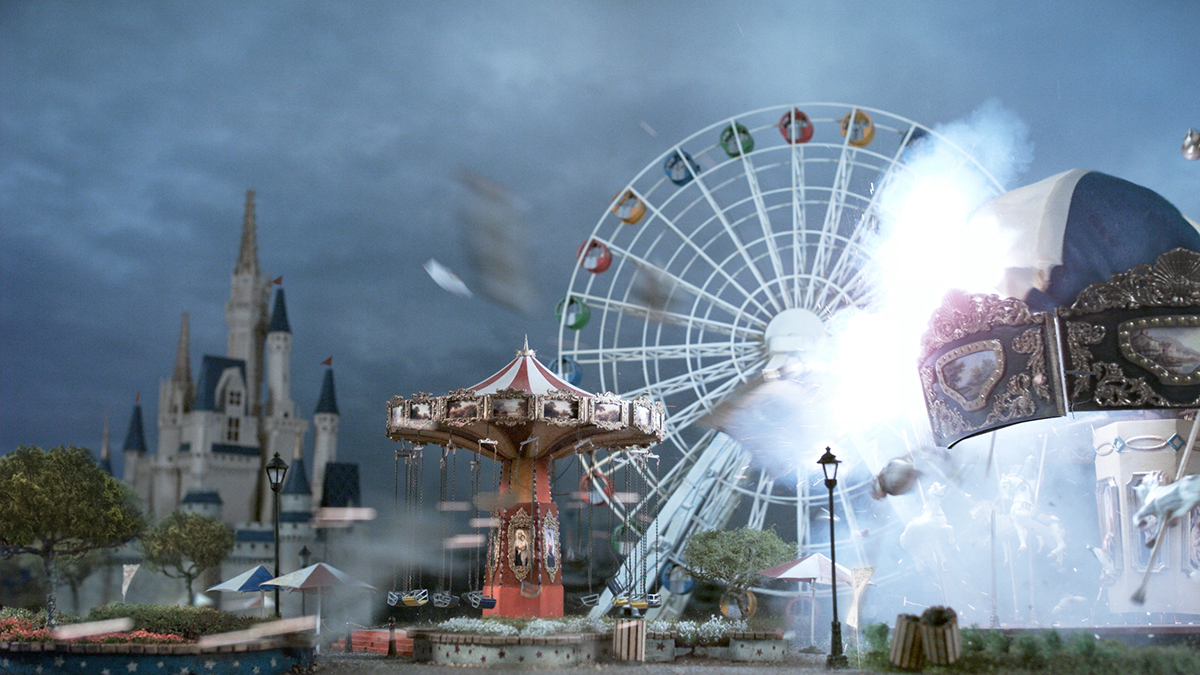明日樂園以明日為題,試圖作為一個對於未來想像的投射,但這個想像面對的未來卻是一個「向死而生」的過程。袁廣鳴創作之初以個人生命經驗及反轉日常事物成為不同觀看經驗為創作主軸,2000年開始,從個人的生命經驗擴及對城市及全球化的的狀態描述,討論的對象逐漸從個人延伸至社會、全球性議題,但作品核心卻不斷叩問生而為人卻終將面對的問題:「我們為何而活、為何存在?」
全球化浪潮所造成的流動,身處在世界經濟結構體系中的我們也不能倖免,即便我們現在居於此處,卻也可能在不久之後迫於經濟、政治、氣候環境而遷移他處。究竟何處為「家」?「家」的概念,在這個時代似乎更為脆弱、流動與擴張。「家」,作為一個人最初始的社會關係建立與認知的場域,也反映自我身分的認同與定位,不僅是實體的居所,也是心靈的歸屬之地。這些現世狀態所造成「家」的不穩定性,也同樣反映在精神層面上,並影響身處這時代的創作者。袁廣鳴的影像往往脫離現實世界的臨場感,轉換為虛幻/虛擬的存在,以幽靈的形式,寄託在作品之中,形成一種徘徊於「無域之所」(non-place)的存在境遇。
與展名同名的新作《明日樂園》,影像中微風靜靜吹拂的無人遊樂園,看似寂靜,卻在片刻後莫名地炸毀。上世紀末的蘇聯解體,原以為為冷戰劃下句點,世界走向太平;但回看如今,世界似乎更為動蕩。後冷戰的年代,安逸的生活似乎只是頃刻的「確幸」,生活背面所潛藏的衝突一觸即發,如環境惡化、金融危機、貧富差距、跨境非法移民、能源危機等,戰爭型態從實體流變至虛擬,更潛移默化至生活中。
「明日樂園」此一命題所揭示的寓意,在本次個展的新作中逐一顯露:從象徵核爆的強光、解嚴之後台灣地區仍持續的演習、象徵全球化、資本主義的迪士尼遊樂園、在台人口比例逐步攀升的移工,到最後新作《向黑》連結因戰亂而迫於遷移離散的意象,每件作品互為文本,環扣著全球化下我們不得不去面對的處境。素來以發掘影像可能性並突破舊有形式見長的袁廣鳴,本次在體驗式演出作品《向黑》中隱去一切光源,試圖回到人類最初始的幽冥狀態,卻又以此作涵蓋本次個展中觸及的在世現象,這種原初狀態,如同加斯東・巴舍拉(Gaston Bachelard)認為有些意象必須以存有的直接臨在狀態來體驗。這種體驗猶如進入一個黑洞,在邁向這黑洞的過程中,或許能找到一種原初的狀態,從內部確認我們的存有。(文字/TKG+Projects提供)
明日樂園─袁廣鳴個展
Tomorrowland — Yuan Goang-Ming Solo Exhibition
展期 Dates:2018.03.03 – 2018.04.29
地點 Venue:TKG+
*展出作品之一 《向黑》 為「體驗式展演」,需預約報名。
*The work Towards Darkness is an immersive live exhibition. Advance online registration is required.
關於袁廣鳴
袁廣鳴的作品以象徵隱喻、結合科技媒材的手法,深刻傳達出人們當下的生存狀態,並且對人的感知及意識有著極具詩意的深入展現。2000年以前的創作,主要以個人的生命經驗及反轉日常事物成就新的觀看現實為創作主軸,2000年開始,從個人的生命經驗擴及對城市及全球化的狀態描述;「逝去中的風景」系列開始對於「家」及「身份」的概念描述,以微型自傳式的手法開創出以一種介於錄像藝術與電影之間的新型格式的動態影像作品、展現劇場式的日常。2014年的個展「不舒適的明日」由「家」的議題延伸至當今在全球化底下的在地生存處境的探問,思辨現代人的困頓與憂懼。
參與的國際重要展歷包括「法國里昂雙年展」(2015)、「福岡亞洲藝術三年展」(2014)、澳洲「亞太當代藝術三年展」(2012)、「新加坡雙年展」(2008)、「英國利物浦雙年展」(2004)、「紐西蘭奧克蘭三年展」(2004)、「第50屆威尼斯雙年展」台灣館(2003)、「漢城國際媒體藝術雙年展」(2002)、美國舊金山現代藝術美術館的「01.01: Art in Technological Times」(2001)等。作品受多所國內外美術館典藏。

Tomorrowland attempts to project an imaginary future that pivots around German philosopher Heidegger’s concept of “being-towards-death.” Drawing from personal life experiences, Yuan Goang-Ming transforms the everyday into different viewing experiences. Since 2000, his focus has shifted to the city and globalization, from individual to social and global issues. But his practice continues to delve into the question that confounds humanity: Why do we live? Why do we exist?
Living in an interconnected economic system, we are not exempt from the wave of globalization. We may very likely be forced to relocate in the foreseeable future due to economic, political, or climatic factors. So where exactly do we call “home”? The idea of “home” seems to be more fragile, fluid, and expanded now more than ever. Home, as the preliminary space where one learns to build relationships, awareness, and identity, is not only a physical living space, but also a sanctuary. “Home” in today’s world is undergoing a drastic change, both on physical and psychological levels. This change has profoundly influenced the artists of our time, including Yuan Goang-Ming. His imagery is often pregnant with a sense of illusion and fictionality that allows his work to linger in a state of non-place.
In Yuan’s new work Tomorrowland, an empty amusement park stands quietly in the breeze, moments before being blown apart by a sudden explosion. After the collapse of the Soviet Union in the late 20th century, the Cold War ended and world peace seemed to have been restored. But now the world has plunged into greater turmoil. In the post-Cold War era, a peaceful life is only a facade, behind which such challenges lurk: environmental degradation, financial crisis, wealth inequality, illegal immigration, and energy crisis. The beginning of a different war dawns. No longer physical, this war insidiously percolates into our life.
Meanings of Tomorrowland are slowly unveiled in the new works on view in this exhibition. Blinding bright light that symbolizes the flash of a nuclear explosion, the air raid drill that continues to take place in Taiwan even after the lift of martial law, Disneyland that represents globalization and capitalism, the rising number of migrant workers in Taiwan, and finally the concept of forced displacement in the new work Towards Darkness. Juxtaposed together, these works highlight the inevitable conflicts that we are faced with in a globalized world. Yuan is known for exploring possibilities in imagery by breaking free from old forms. In the immersive live exhibition Towards Darkness, a lightless space evokes the human embryonic stage, while hinting at the social issues touched upon in this exhibition. As French philosopher Gaston Bachelard once said, some imagery can only be experienced through being directly in its existing presence. This experience, much like walking into a black hole, could perhaps lead us towards a primordial state, allowing us to verify our existence from within. (Text / TKG+ Projects)
About the artist
Combining symbolic metaphors with technological media, Yuan Goang-Ming’s work expresses the state of contemporary existence, and explores the human mind and consciousness. Before 2000, his practice revolved around personal experiences and the transformation of the everyday into new viewing experiences. Beginning in 2000, he shifted his focus toward the city and globalization. Disappearing Landscape (2007) combines video art and cinema, displaying the fascinating, theatrical everyday in three-channel video installations. His 2014 solo exhibition An Uncanny Tomorrow questions the environment we inhabit in a globalized context, pondering the anxieties and apprehensions of modern people.
Yuan Goang-Ming has exhibited internationally, including Biennale de Lyon: La Vie Moderne, France (2015); Fukuoka Asian Art Triennale, Japan (2014); the 7th Asia Pacific Triennial of Contemporary Art, Australia (2012); Singapore Biennale (2008); Liverpool Biennial, U.K. (2004); Auckland Triennial, New Zealand (2004); the Taiwan Pavilion at the 50th Venice Biennale, Italy (2003); the 2nd Seoul International Media Art Biennale, Korea (2002); and 010101: Art in Technological Times at the San Francisco Museum of Modern Art (2001). His work is housed in public and private collections of art museums and institutions domestic and abroad.

